Study on 2007–2021 Drought Trends in Basilicata Region Based on the AMSU-Based Soil Wetness Index
Abstract
1. Introduction
2. Materials and Methods
2.1. The Study Area
2.2. Data Source
2.2.1. Satellite Dataset
2.2.2. SPEI Data
2.3. Method
- SWI MetOp-B data—2013–2016: Agreement between series achieved considering diurnal (ascending) and nighttime (descending) orbits at the river basin scale. An intra-comparison between the basins was also conducted.
- SWI MetOp-A and -B data—2013–2016: Agreement between series achieved by considering nighttime (descending) orbits at the river basin scale.
- SWI MetOp-A and -B data, SM ASCAT MetOp-A and -B data—2013–2016: Agreement between series achieved by considering nighttime (descending) orbits at the river basin scale
- SWI MetOp-A—2007–2021: Analysis of the long-term trend of SWI variability for MetOp-A data in ascending orbits at the regional scale, also performing an intra-comparison between the basins. Finally, a comparison was made using SPEI measurements.
Statistical Analysis
3. Results
3.1. The Consistency of SWI Product
3.2. Correlation of SWI Variations by Using Different Satellites
3.3. Correlation of SWI Products Derived from AMSU and ASCAT
3.4. Long-Term Variation of SWI for Basilicata Region
3.5. Assessing Drought Process
4. Discussion
5. Conclusions
Author Contributions
Funding
Data Availability Statement
Acknowledgments
Conflicts of Interest
Appendix A

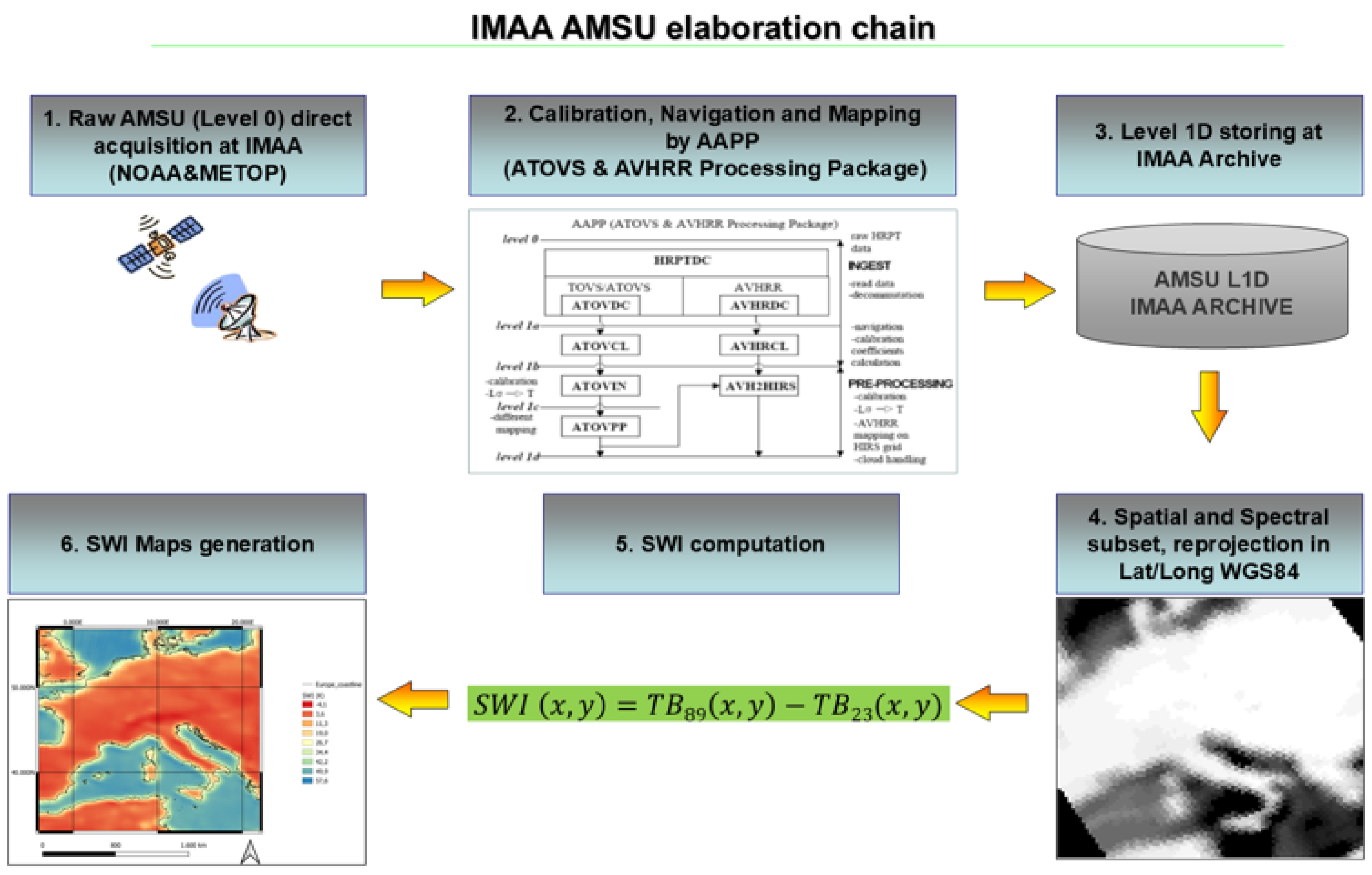


References
- Stott, P.A.; Christidis, N.; Otto, F.E.L.; Sun, Y.; Vanderlinden, J.-P.; van Oldenborgh, G.J.; Vautard, R.; von Storch, H.; Walton, P.; Yiou, P.; et al. Attribution of extreme weather and climate-related events. WIREs Clim. Change 2016, 7, 23–41. [Google Scholar] [CrossRef] [PubMed]
- Martínez-Fernández, J.; González-Zamora, A.; Sánchez, N.; Gumuzzio, A. A soil water based index as a suitable agricultural drought indicator. J. Hydrol. 2015, 522, 265–273. [Google Scholar] [CrossRef]
- Carrão, H.; Russo, S.; Sepulcre-Canto, G.; Barbosa, P. An empirical standardized soil moisture index for agricultural drought assessment from remotely sensed data. Int. J. Appl. Earth Obs. Geoinf. 2016, 48, 74–84. [Google Scholar] [CrossRef]
- Crausbay, S.D.; Ramirez, A.R.; Carter, S.L.; Cross, M.S.; Hall, K.R.; Bathke, D.J.; Betancourt, J.L.; Colt, S.; Cravens, A.E.; Dalton, M.S.; et al. Defining Ecological Drought for the Twenty-First Century. Bull. Am. Meteorol. Soc. 2017, 98, 2543–2550. [Google Scholar] [CrossRef]
- Maracchi, G. Agricultural Drought—A Practical Approach to Definition, Assessment and Mitigation Strategies. In Drought and Drought Mitigation in Europe; Vogt, J.V., Somma, F., Eds.; Advances in Natural and Technological Hazards Research; Springer: Dordrecht, The Netherlands, 2000; Volume 14. [Google Scholar] [CrossRef]
- Afshar, M.H.; Bulut, B.; Duzenli, E.; Amjad, M.; Yilmaz, M.T. Global spatiotemporal consistency between meteorological and soil moisture drought indices. Agric. For. Meteorol. 2022, 316, 108848. [Google Scholar] [CrossRef]
- Spinoni, J.; Naumann, G.; Vogt, J. Spatial patterns of European droughts under a moderate emission scenario. Adv. Sci. Res. 2015, 12, 179–186. [Google Scholar] [CrossRef]
- Pascale, S.; Ragone, F. Widespread Multi-Year Droughts in Italy: Identification and Causes of Development. Int. J. Climatol. 2025, e8827. [Google Scholar] [CrossRef]
- Baronetti, A.; González-Hidalgo, J.C.; Vicente-Serrano, S.M.; Acquaotta, F.; Fratianni, S. A weekly spatio-temporal distribution of drought events over the Po Plain (North Italy) in the last five decades. Int. J. Climatol. 2020, 40, 4463–4476. [Google Scholar] [CrossRef]
- Romano, E.; Petrangeli, A.B.; Salerno, F.; Guyennon, N. Do recent meteorological drought events in central Italy result from long-term trend or increasing variability. Int. J. Climatol. 2021, 42, 4111–4128. [Google Scholar] [CrossRef]
- Coscarelli, R.; Caloiero, T.; Filice, E.; Marsico, L.; Rotundo, R. Meteorological Drought Characterization in the Calabria Region (Southern Italy). Climate 2023, 11, 160. [Google Scholar] [CrossRef]
- Venturi, S.; Dunea, D.; Mateescu, E.; Virsta, A.; Petrescu, N.; Casadei, S. SPEI and SPI correlation in the study of drought phenomena in Umbria region (central Italy). Environ. Sci. Pollut. Res. 2025, 32, 168–188. [Google Scholar] [CrossRef] [PubMed]
- Mazzariello, A.; Albano, R.; Lacava, T.; Manfreda, S.; Sole, A. Intercomparison of recent microwave satellite soil moisture products on European ecoregions. J. Hydrol. 2023, 626, 130311. [Google Scholar] [CrossRef]
- Albano, R.; Lacava, T.; Mazzariello, A.; Manfreda, S.; Adamowski, J.; Sole, A. How Can Seasonality Influence the Performance of Recent Microwave Satellite Soil Moisture Products? Remote Sens. 2024, 16, 3044. [Google Scholar] [CrossRef]
- Li, Y.X.; Leng, P.; Kasim, A.A.; Li, Z.L. Spatiotemporal variability and dominant driving factors of satellite observed global soil moisture from 2001 to 2020. J. Hydrol. 2025, 654, 132848. [Google Scholar] [CrossRef]
- Normandin, C.; Frappart, F.; Bourrel, L.; Blarel, F.; Biancamaria, S.; Wigneron, J.P.; Galenon, L.; Bernard, E.; Coulon, L.; Lubac, B.; et al. Sharp decline in surface water resources for agriculture and fisheries in the Lower Mekong Basin over 2000–2020. Sci. Total Environ. 2024, 950, 175259. [Google Scholar] [CrossRef] [PubMed]
- Sylvestre, F.; Mahamat-Nour, A.; Naradoum, T.; Alcoba, M.; Gal, L.; Paris, A.; Cretaux, J.-F.; Pham-Duc, B.; Lescoulier, C.; Recouvreur, R.; et al. Strengthening of the hydrological cycle in the Lake Chad Basin under current climate change. Sci. Rep. 2024, 14, 24639. [Google Scholar] [CrossRef]
- Brown, J.F.; Wardlow, B.D.; Tadesse, T.; Hayes, M.J.; Reed, B.C. The Vegetation Drought Response Index (VegDRI): A new integrated approach for monitoring drought stress in vegetation. GISci. Remote Sens. 2008, 45, 16–46. [Google Scholar] [CrossRef]
- Martínez-Fernández, J.; González-Zamora, A.; Sánchez, N.; Gumuzzio, A. Herrero-Jiménez CM. Satellite soil moisture for agricultural drought monitoring: Assessment of the SMOS derived Soil Water Deficit Index. Remote Sens. Environ. 2016, 177, 277–286. [Google Scholar] [CrossRef]
- West, H.; Quinn, N.; Horswell, M. Remote sensing for drought monitoring & impact assessment: Progress, past challenges and future opportunities. Remote Sens. Environ. 2019, 232, 111291. [Google Scholar] [CrossRef]
- Bhardwaj, J.; Kuleshov, Y.; Chua, Z.W.; Watkins, A.B.; Choy, S.; Sun, Q. Evaluating satellite soil moisture datasets for drought monitoring in Australia and the Southwest Pacific. Remote Sens. 2022, 14, 3971. [Google Scholar] [CrossRef]
- Bolten, J.D.; Crow, W.T.; Zhan, X.; Jackson, T.J. Reynolds CA. Evaluating the Utility of Remotely Sensed Soil Moisture Retrievals for Operational Agricultural Drought Monitoring. IEEE J. Sel. Top. Appl. Earth Obs. Remote Sens. 2010, 3, 57–66. [Google Scholar] [CrossRef]
- Brocca, L.; Crow, W.T.; Ciabatta, L.; Massari, C.; de Rosnay, P.; Enenkel, M.; Hahn, S.; Amarnath, G.; Camici, S.; Tarpanelli, A.; et al. A Review of the Applications of ASCAT Soil Moisture Products. IEEE J. Sel. Top. Appl. Earth Obs. Remote Sens. 2017, 10, 2285–2306. [Google Scholar] [CrossRef]
- Chakraborty, A.; Seshasai, M.V.R.; Murthy, C.S.; Rao, S.V.C.K. Assessing early season drought condition using AMSR-E soil moisture product. Geomat. Nat. Hazards Risk 2012, 4, 164–186. [Google Scholar] [CrossRef][Green Version]
- Crocetti, L.; Forkel, M.; Fischer, M.; Jurečka, F.; Grlj, A.; Salentinig, A.; Trnka, M.; Anderson, M.; Ng, W.-T.; Kokalj, Ž.; et al. Earth Observation for agricultural drought monitoring in the Pannonian Basin (southeastern Europe): Current state and future directions. Reg. Environ. Chang. 2020, 20, 123. [Google Scholar] [CrossRef]
- Du, J.; Kimball, J.S.; Velicogna, I.; Zhao, M.; Jones, L.A.; Watts, J.D.; Kim, Y. Multicomponent Satellite Assessment of Drought Severity in the Contiguous United States from 2002 to 2017 Using AMSR-E and AMSR2. Water Resour. Res. 2019, 55, 5394–5412. [Google Scholar] [CrossRef]
- Kędzior, M.; Zawadzki, J. SMOS data as a source of the agricultural drought information: Case study of the Vistula catchment, Poland. Geoderma 2017, 306, 167–182. [Google Scholar] [CrossRef]
- El Hajj, M.; Baghdadi, N.; Zribi, M.; Rodríguez-Fernández, N.; Wigneron, J.P.; Al-Yaari, A.; Al Bitar, A.; Albergel, C.; Calvet, J.C. Evaluation of SMOS, SMAP, ASCAT and Sentinel-1 soil moisture products at sites in Southwestern France. Remote Sens. 2018, 10, 569. [Google Scholar] [CrossRef]
- Jung, H.C.; Kang, D.H.; Kim, E.; Getirana, A.; Yoon, Y.; Kumar, S.; Peters-lidard, C.D.; Hwang, E. Towards a soil moisture drought monitoring system for South Korea. J. Hydrol. 2020, 589, 125176. [Google Scholar] [CrossRef]
- Mishra, A.; Vu, T.; Veettil, A.V.; Entekhabi, D. Drought monitoring with soil moisture active passive (SMAP) measurements. J. Hydrol. 2017, 552, 620–632. [Google Scholar] [CrossRef]
- Rassl, A.; Michel, D.; Hirschi, M.; Duguay-Tetzlaff, A.; Seneviratne, S.I. Climatological Drought Monitoring in Switzerland Using EUMETSAT SAF Satellite Data. Remote Sens. 2022, 14, 5961. [Google Scholar] [CrossRef]
- Sadri, S.; Pan, M.; Wada, Y.; Vergopolan, N.; Sheffield, J.; Famiglietti, J.S.; Kerr, Y.; Wood, E. A global near-real-time soil moisture index monitor for food security using integrated SMOS and SMAP. Remote Sens. Environ. 2020, 246, 111864. [Google Scholar] [CrossRef]
- Sánchez, N.; González-Zamora, Á.; Piles, M.; Martínez-Fernández, J. A new Soil Moisture Agricultural Drought Index (SMADI) integrating MODIS and SMOS products: A case of study over the Iberian Peninsula. Remote Sens. 2016, 8, 287. [Google Scholar] [CrossRef]
- Thi, N.Q.; Govind, A.; Ha, T.V. Spatial and temporal variability of soil moisture active and passive (SMAP) droughts and their impacts on vegetation in the Central Highlands of Vietnam. Environ. Monit. Assess. 2025, 197, 203. [Google Scholar] [CrossRef] [PubMed]
- Velpuri, N.M.; Senay, G.B.; Morisette, J.T. Evaluating new SMAP soil moisture for drought monitoring in the rangelands of the us high plains. Rangelands 2016, 38, 183–190. [Google Scholar] [CrossRef]
- Xu, Y.; Wang, L.; Ross, K.W.; Liu, C.; Berry, K. Standardized Soil Moisture Index for Drought Monitoring Based on Soil Moisture Active Passive Observations and 36 Years of North American Land Data Assimilation System Data: A Case Study in the Southeast United States. Remote Sens. 2018, 10, 301. [Google Scholar] [CrossRef]
- Zhu, Q.; Luo, Y.; Xu, Y.-P.; Tian, Y.; Yang, T. Satellite soil moisture for agricultural drought monitoring: Assessment of SMAP-derived Soil Water Deficit Index in Xiang River Basin, China. Remote Sens. 2019, 11, 362. [Google Scholar] [CrossRef]
- De Ridder, K. Surface soil moisture monitoring over Europe using Special Sensor Microwave/Imager (SSM/I) imagery. J. Geophys. Res. 2003, 108, ACL6.1–ACL6.10. [Google Scholar] [CrossRef]
- Li, L.; Gaiser, P.W.; Gao, B.C.; Bevilacuqa, R.M.; Jackson, T.J.; Njoku, E.G. WindSat Global Soil Moisture Retrieval and Validation. IEEE Trans. Geosci. Remote Sens. 2010, 48, 2224–2241. [Google Scholar] [CrossRef]
- Lacava, T.; Cuomo, V.; Di Leo, E.V.; Pergola, N.; Romano, F.; Tramutoli, V. Improving soil wetness variations monitoring from passive microwave satellite data: The case of April 2000 Hungary flood. Remote Sens. Environ. 2005, 96, 135–148. [Google Scholar] [CrossRef]
- Yang, W.; Meng, H.; Ferraro, R.R.; Chen, Y. Inter-Calibration of AMSU-A Window Channels. Remote Sens. 2020, 12, 2988. [Google Scholar] [CrossRef]
- Grody, N.C.; Weng, F.; Ferraro, R.R. Application of AMSU for hydrological parameters. In Microwave Radiometry and Remote Sensing of the Earth’s Surface and Atmosphere; Pampaloni, P., Paloscia, S., Eds.; VSP: Delft, The Netherlands, 2000; pp. 339–352. [Google Scholar]
- Tramutoli, V. Robust Satellite Techniques (RST) for natural and environmental hazards monitoring and mitigation: Theory and applications. In Proceedings of the 2007 International Workshop on the Analysis of Multi-Temporal Remote Sensing Images, Leuven, Belgium, 18–20 July 2007. [Google Scholar] [CrossRef]
- Lacava, T.; Greco, M.; Di Leo, E.V.; Martino, G.; Pergola, N.; Sannazzaro, F.; Tramutoli, V. Monitoring soil wetness variations by means of satellite passive microwave observations: The HYDROPTIMET study cases. Nat. Hazards Earth Syst. Sci. 2005, 5, 583–592. [Google Scholar] [CrossRef]
- Lacava, T.; Greco, M.; Di Leo, E.V.; Martino, G.; Pergola, N.; Romano, F.; Sannazzaro, F.; Tramutoli, V. Assessing the potential of SWVI (Soil Wetness Variation Index) for hydrological risk monitoring by satellite microwave observations. Adv. Geosci. 2005, 2, 221–227. [Google Scholar] [CrossRef][Green Version]
- Lacava, T.; Brocca, L.; Calice, G.; Melone, F.; Moramarco, T.; Pergola, N.; Tramutoli, V. Soil moisture variations monitoring by AMSU-based soil wetness indices: A long-term inter-comparison with ground measurements. Remote Sens. Environ. 2010, 114, 2317–2325. [Google Scholar] [CrossRef]
- Manfreda, S.; Lacava, T.; Onorati, B.; Pergola, N.; Di Leo, M.; Margiotta, M.R.; Tramutoli, V. On the use of AMSU-based products for the description of soil water content at basin scale. Hydrol. Earth Syst. Sci. 2011, 15, 2839–2852. [Google Scholar] [CrossRef]
- Coluzzi, R.; D’emilio, M.; Imbrenda, V.; Giorgio, G.A.; Lanfredi, M.; Macchiato, M.; Ragosta, M.; Simoniello, T.; Telesca, V. Investigating climate variability and long-term vegetation activity across heterogeneous Basilicata agroecosystems. Geomat. Nat. Hazards Risk 2018, 10, 168–180. [Google Scholar] [CrossRef]
- Marzia, G.; Previtali, M. A GIS and Remote Sensing Approach for Desertification Sensitivity Assessment in Basilicata Region (Italy), Paper presented at ICGDA 2020. In Proceedings of the 2020 3rd International Conference on Geoinformatics and Data Analysis (ICGDA ‘20), New York, NY, USA, 1 July 2020; pp. 62–66. [Google Scholar] [CrossRef]
- Canora, F.; D’Angella, A.; Aiello, A. Quantitative assessment of the sensitivity to desertification in the Bradano River basin (Basilicata, southern Italy). J. Maps 2014, 11, 745–759. [Google Scholar] [CrossRef]
- Cillis, G.; Tucci, B.; Santarsiero, V.; Nolè, G.; Lanorte, A. Understanding Land Changes for Sustainable Environmental Management: The Case of Basilicata Region (Southern Italy). Pollutants 2021, 1, 217–233. [Google Scholar] [CrossRef]
- Bartalis, Z.; Naeimi, V.; Hasenauer, S.; Wagner, W. ASCAT Soil Moisture Product Handbook. In ASCAT Soil Moisture Report Series; Institute of Photogrammetry and Remote Sensing, Vienna University of Technology: Vienna, Austria, 2008; Volume 15. [Google Scholar]
- Wagner, W.; Hahn, S.; Kidd, R.; Melzer, T.; Bartalis, Z.; Hasenauer, S.; Figa, J.; De Rosnay, P.; Jann, A.; Schneider, S.; et al. The ASCAT Soil Moisture Product: A Review of its Specifications, Validation Results, and Emerging Applications. Meteorol. Z. 2013, 22, 5–33. [Google Scholar] [CrossRef]
- Escorihuela, M.J.; Quintana-Seguí, P. Comparison of remote sensing and simulated soil moisture datasets in Mediterranean landscapes. Remote Sens. Environ. 2016, 180, 99–114. [Google Scholar] [CrossRef]
- Brocca, L.; Ciabatta, L.; Massari, C.; Camici, S.; Tarpanelli, A. Soil Moisture for Hydrological Applications: Open Questions and New Opportunities. Water 2017, 9, 140. [Google Scholar] [CrossRef]
- Vicente-Serrano, S.M.; Beguería, S.; López-Moreno, J.I. A Multi-scalar drought index sensitive to global warming: The Standardized Precipitation Evapotranspiration Index—SPEI. J. Clim. 2010, 23, 1696–1718. [Google Scholar] [CrossRef]
- Imbrenda, V.; Lanfredi, M.; Coluzzi, R.; Simoniello, T. A smart procedure for assessing the health status of terrestrial habitats in protected areas: The case of the natura 2000 ecological network in Basilicata (southern Italy). Remote Sens. 2022, 14, 2699. [Google Scholar] [CrossRef]
- Coda, S.; Allocca, P.; Calcaterra, D.; Castello, N.; Cusano, D.; De Vita, P.; Lepore, D.; Petrone, P.; Prosser, G.; Allocca, V. Hydrogeology of the lower sector of Basento and Cavone river basins (southern Italy). J. Maps 2025, 21, 2451786. [Google Scholar] [CrossRef]
- Romano, S.; Cozzi, M.; Viccaro, M.; di Napoli, F. The Green Economy for Sustainable Development: A Spatial Multi-Criteria Analysis—Ordered Weighted Averaging Approach in the Siting Process for Short Rotation Forestry in the Basilicata Region, Italy. Ital. J. Agron. 2013, 8, e21. [Google Scholar] [CrossRef]
- Autorità di Bacino della Basilicata. Piano di Gestione del Rischio di Alluvioni. 2015. Available online: https://www.distrettoappenninomeridionale.it/wp-content/uploads/2024/01/r.4.5-rel.-basilicata.pdf (accessed on 3 June 2025).
- Goodrum, G.; Kidwell, K.B.; Winston, W. (Eds.) NOAA KLM User’s Guide; NOAA: Suitland, MD, USA, 1997; NOAA-NESDIS/NCDC.
- Ferraro, R.R.; Weng, F.; Grody, N.C.; Zhao, L.; Meng, H.; Kongoli, C.; Pellegrino, P.; Qiu, S.; Dean, C. NOAA operational hydrological products derived from the advanced microwave sounding unit. IEEE Trans. Geosci. Remote Sens. 2005, 43, 1036–1049. [Google Scholar] [CrossRef]
- Lakshmi, V.; Wood, E.F.; Choudhury, B.J. Evaluation of special sensor microwave/imager satellite data for regional soil moisture estimation over the red river basin. J. Appl. Meteorol. 1997, 36, 1309–1328. [Google Scholar] [CrossRef]
- Prigent, C.; Rossow, W.B.; Matthews, E. Microwave land surface emissivity estimated from SSM/I. J. Geophys. Res. 1997, 102, 867–890. [Google Scholar]
- Basist, A.; Grody, N.; Peterson, T.C.; Williams, C.N. Using the special sensor microwave/imager to monitor land surface temper atures, wetness, and snow cover. J. Appl. Meteorol. 1998, 37, 888–911. [Google Scholar] [CrossRef]
- Basist, A.; Williams, C., Jr.; Ross, T.F.; Menne, M.J.; Grody, N.; Ferraro, R.; Shen, S.; Chang, A.T. Using the special sensor microwave/imager to monitor surface wetness. J. Hydrol. 2001, 2, 297–308. [Google Scholar]
- NWP SAF. ATOVS and AVHRR Pre-Processing Package (AAPP). 2024. Available online: https://nwp-saf.eumetsat.int/site/software/aapp/ (accessed on 3 June 2025).
- ESA. MetOp Status, ESA Bulletin, No 145, February 2011, p. 84. 2011. Available online: https://esamultimedia.esa.int/multimedia/publications/ESA-Bulletin-145/ESA-Bulletin-145.pdf (accessed on 3 June 2025).
- EUMETSAT. Anomaly Channel-15 AMSU-A on MetOp-B, Service Alert n. 2294. 2016. Available online: https://uns.eumetsat.int/?filter=permanentfailures (accessed on 3 June 2025).
- Wagner, W.; Lemoine, G.; Rott, H. A Method for Estimating Soil Moisture from ERS Scatterometer and Soil Data. Remote Sens. Environ. 1999, 70, 191–207. [Google Scholar] [CrossRef]
- H SAF. ASCAT Surface Soil Moisture Climate Data Record v5 12.5 km Sampling—Metop; EUMETSAT SAF on Support to Operational Hydrology and Water Management: Darmstadt, Germany, 2020. [Google Scholar] [CrossRef]
- Beguería, S.; Latorre, B.; Reig, F.; Vicente-Serrano, S.M. Global SPEI Database. 2024. Available online: https://spei.csic.es/database.html (accessed on 3 June 2025).
- Durbin, J.; Watson, G.S. Testing for serial correlation in least squares regression. I. Biometrika. 1950, 37, 409–428. [Google Scholar] [PubMed]
- Shapiro, S.S.; Wilk, M.B. An Analysis of Variance Test for Normality (Complete Samples). Biometrika 1965, 52, 591–611. [Google Scholar] [CrossRef]
- Pearson, K. Notes on Regression and Inheritance in the Case of Two Parents. Proc. R. Soc. Lond. 1895, 58, 240–242. [Google Scholar] [CrossRef]
- Sen, P.K. Estimates of the regression coefficient based on Kendall’s tau. J. Am. Stat. Assoc. 1968, 63, 1379–1389. [Google Scholar] [CrossRef]
- Zeng, Z.; Wu, W.; Peñuelas, J.; Li, Y.; Jiao, W.; Li, Z.; Ren, X.; Wang, K.; Ge, Q. Increased risk of flash droughts with raised concurrent hot and dry extremes under global warming. npj Clim. Atmos. Sci. 2023, 6, 134. [Google Scholar] [CrossRef]
- Gabriele, M.; Brumana, R.; Previtali, M.; Cazzani, A. A combined GIS and remote sensing approach for monitoring climate change-related land degradation to support landscape preservation and planning tools: The Basilicata case study. Appl. Geomat. 2023, 15, 497–532. [Google Scholar] [CrossRef]
- The Blue Community. Italy: Water Crisis in Basilicata. 2024. Available online: https://blue-community.net/2024/12/09/italy-water-crisis-in-basilicata/ (accessed on 3 June 2025).
- Ionita, M.; Nagavciuc, V. Changes in drought features at the European level over the last 120 years. Nat. Hazards Earth Syst. Sci. 2021, 21, 1685–1701. [Google Scholar] [CrossRef]
- Iturbide, M.; Gutiérrez, J.M.; Alves, L.M.; Bedia, J.; Cerezo-Mota, R.; Cimadevilla, E.; Cofiño, A.S.; Di Luca, A.; Faria, S.H.; Gorodetskaya, I.V.; et al. An update of IPCC climate reference regions for subcontinental analysis of climate model data: Definition and aggregated datasets. Earth Syst. Sci. Data. 2020, 12, 2959–2970. [Google Scholar] [CrossRef]
- Vicente-Serrano, S.M.; Domínguez-Castro, F.; Murphy, C.; Hannaford, J.; Reig, F.; Peña-Angulo, D.; Tramblay, Y.; Trigo, R.M.; Mac Donald, N.; Luna, M.Y.; et al. Long-term variability and trends in meteorological droughts in Western Europe (1851–2018). Int. J. Clim. 2021, 41, E690–E717. [Google Scholar] [CrossRef]
- Mirauda, D.; Cirigliano, S. A comparative analysis of drought indices in evaluating climate change impacts on agriculture in Southern Italy. 21 May 2024; PREPRINT (Version 1). [Google Scholar] [CrossRef]
- McKee, T.B.; Doesken, N.J.; Kleist, J. The relationship of drought frequency and duration to time scales. In Proceedings of the 8th Conference on Applied Climatology, Anaheim, CA, USA, 17–22 January 1993; Americ Meteorol Soc: Fort Collins, CO, USA; pp. 179–184, Mass. [Google Scholar]
- Tsakiris, G.; Vangelis, H. Establishing a drought index incorporating evapotranspiration. Eur. Water 2005, 9, 3–11. [Google Scholar]
- Space It up. 2025. Available online: https://spaceitup.it/ (accessed on 3 June 2025).
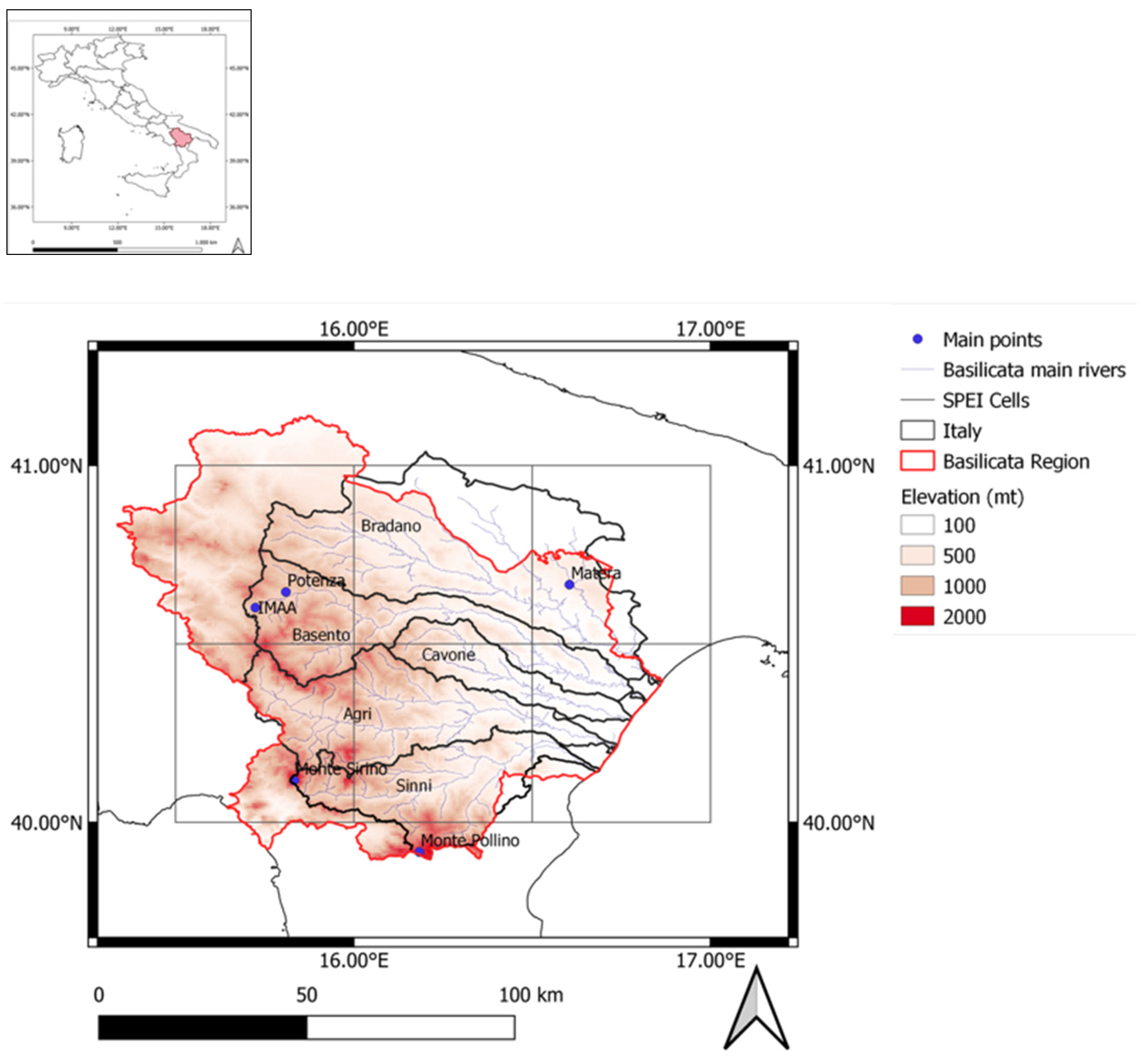
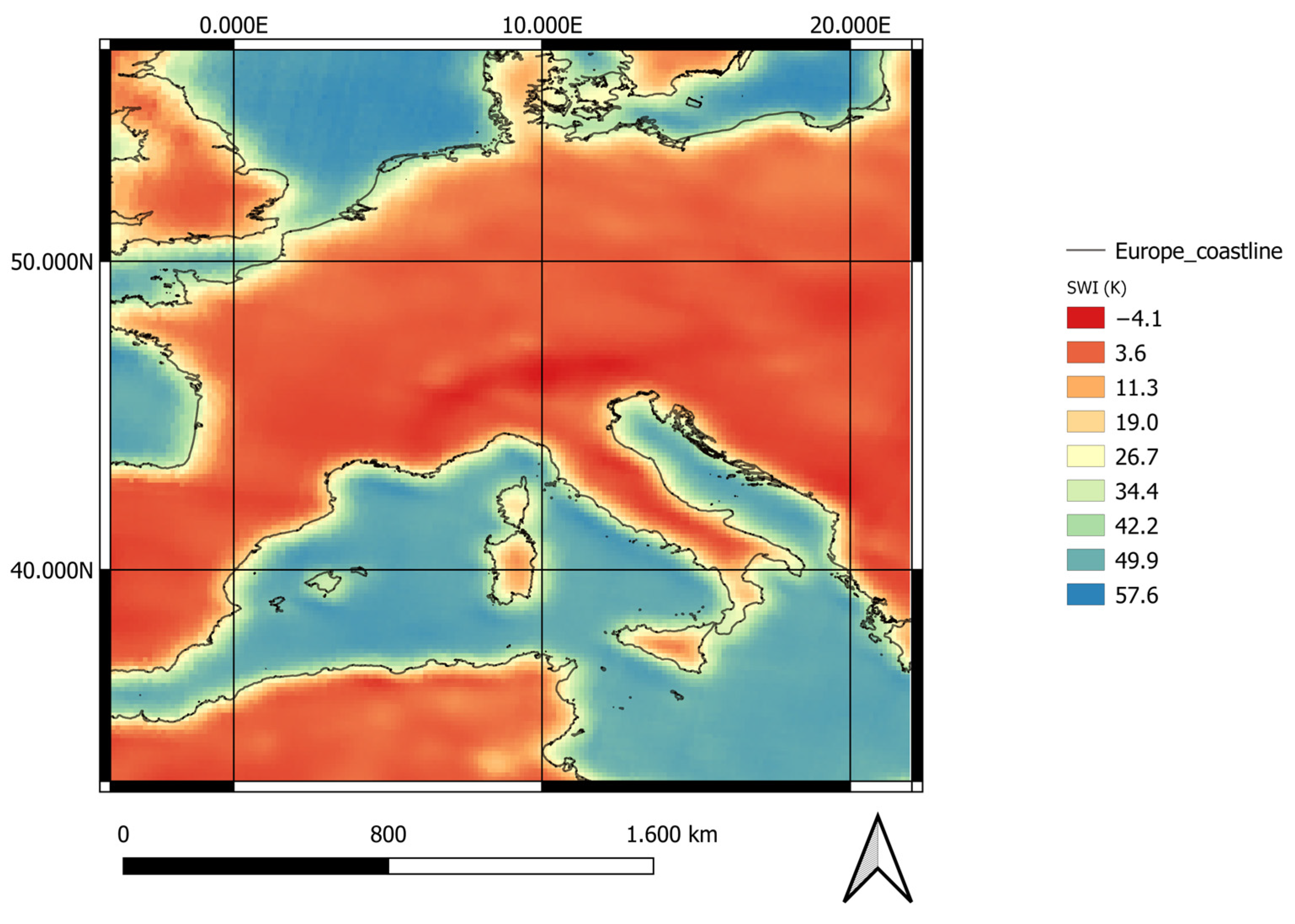

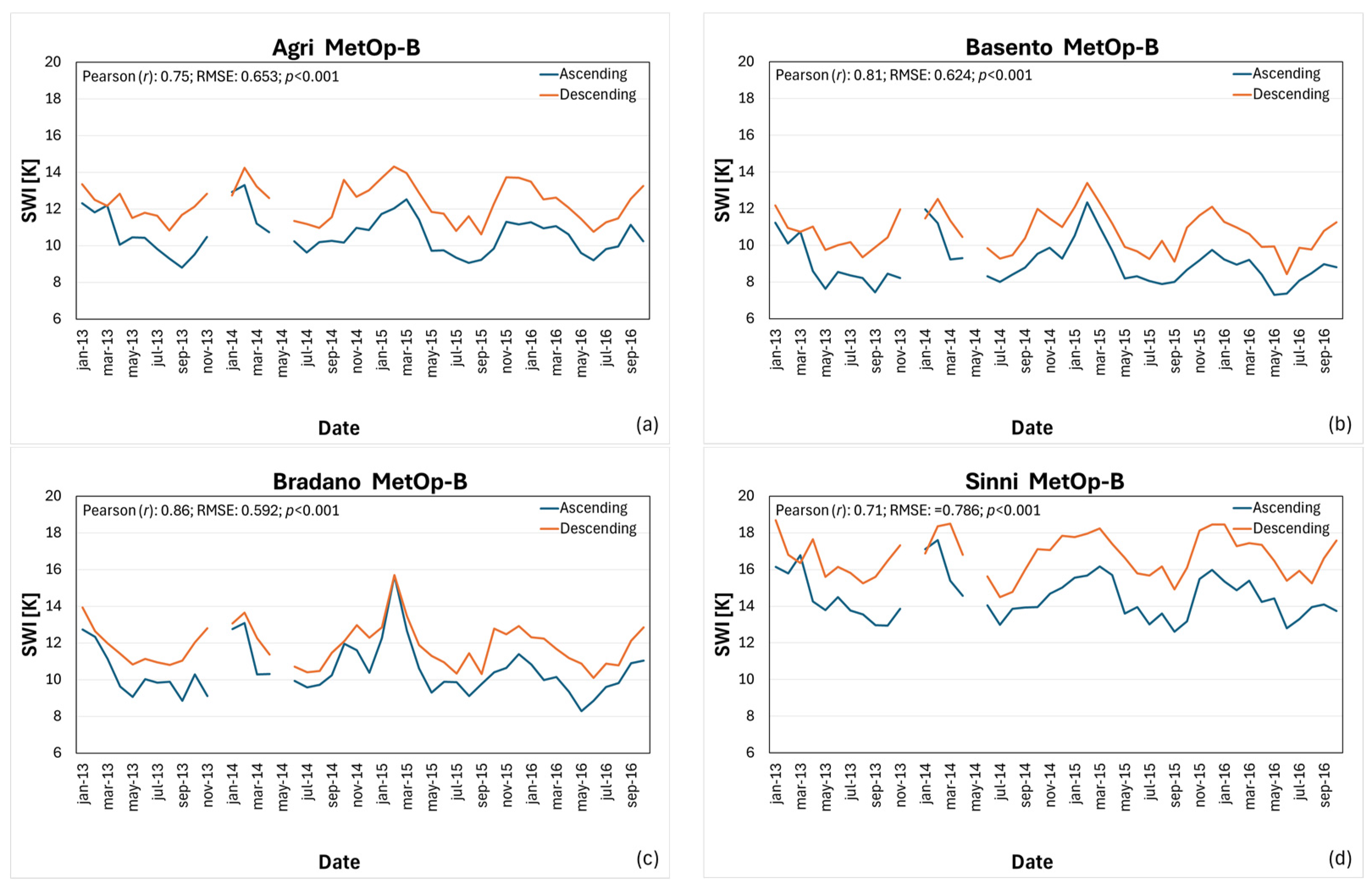
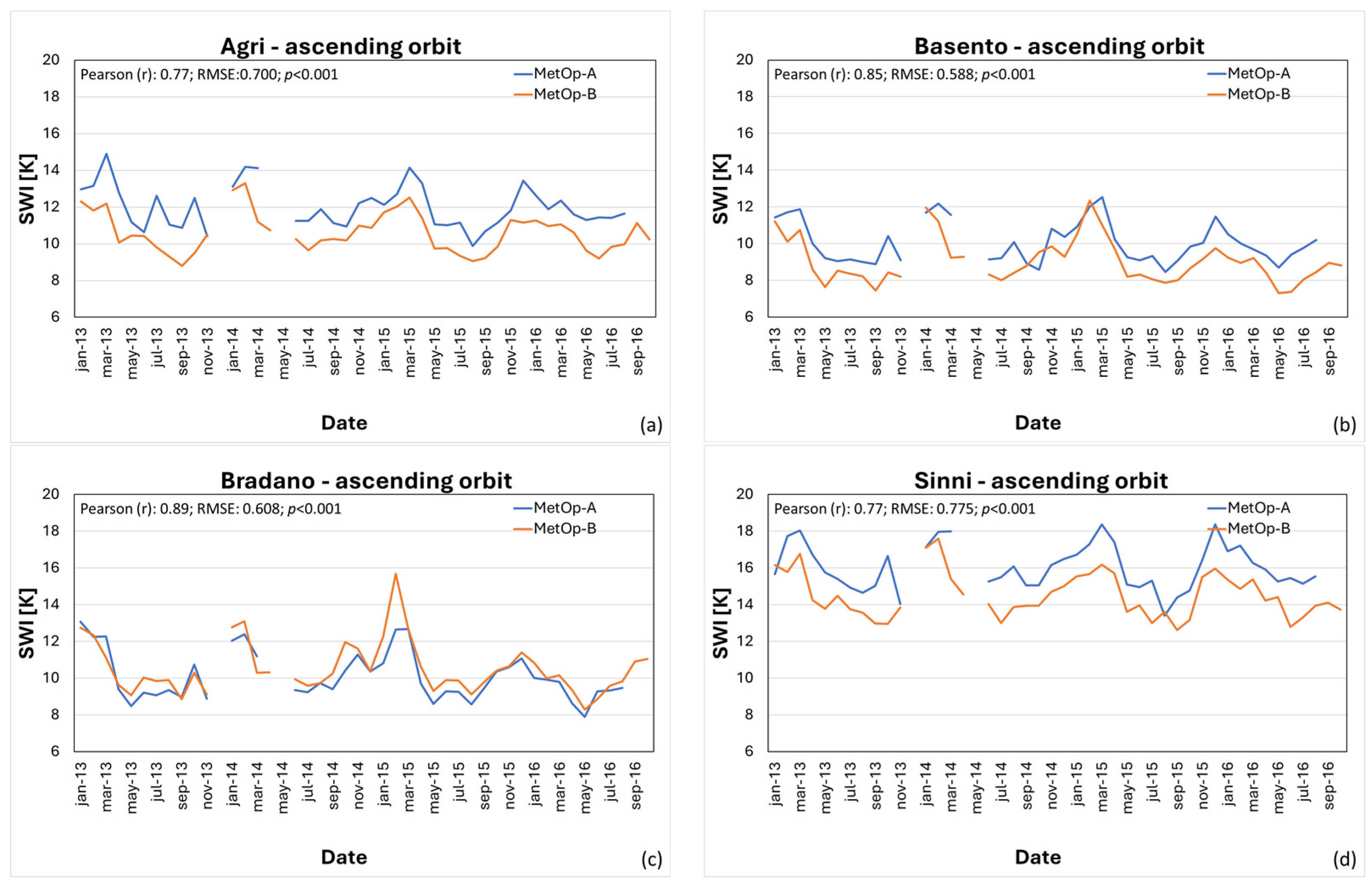

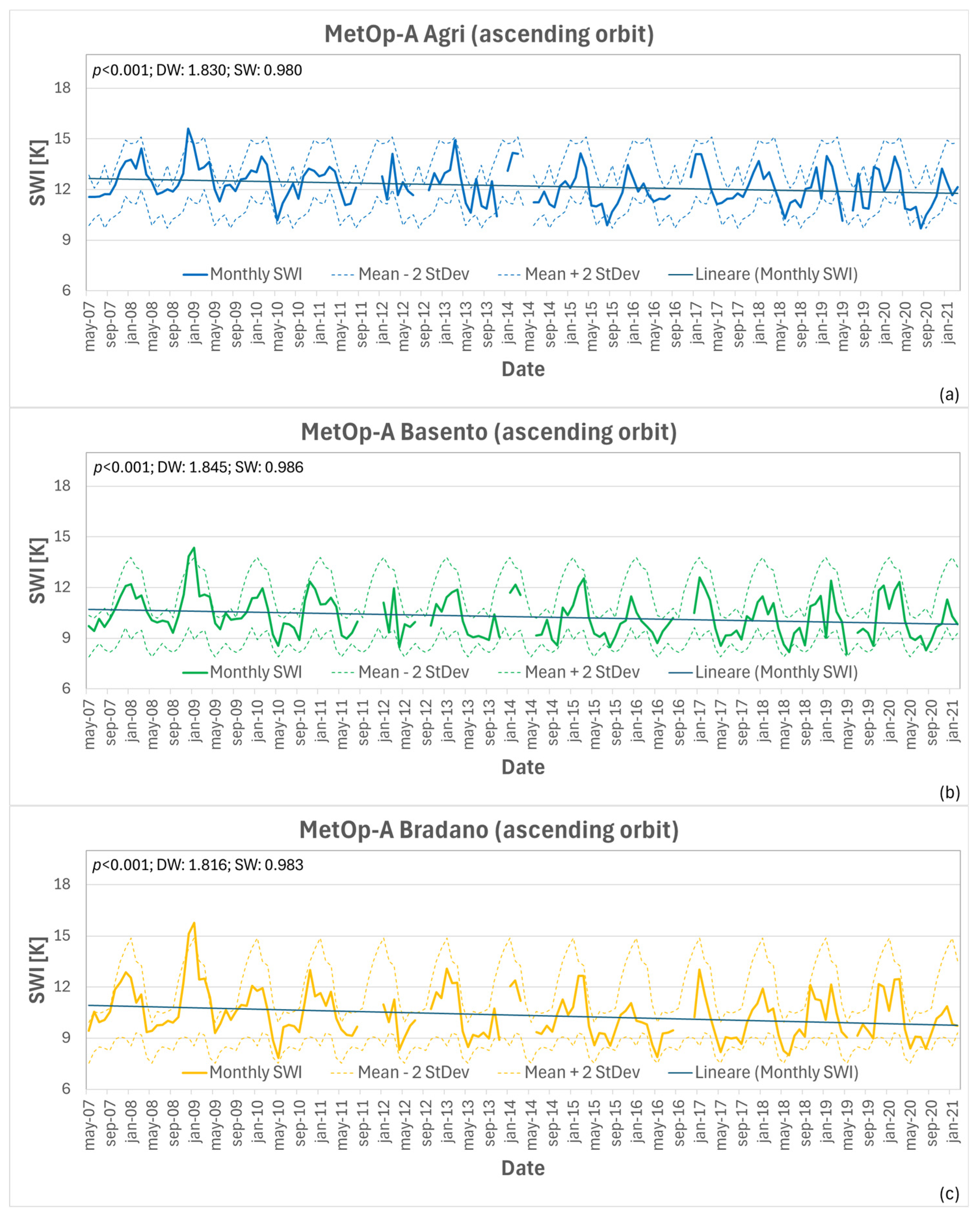
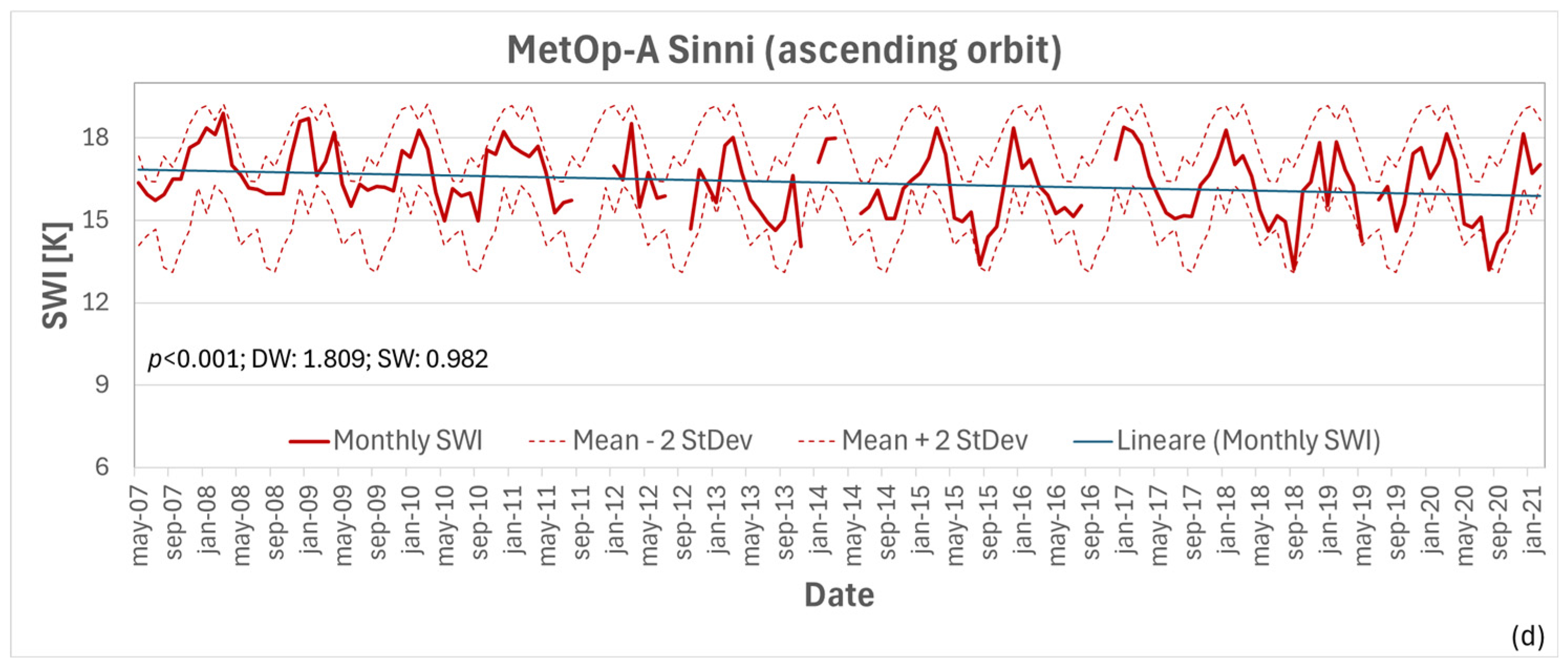
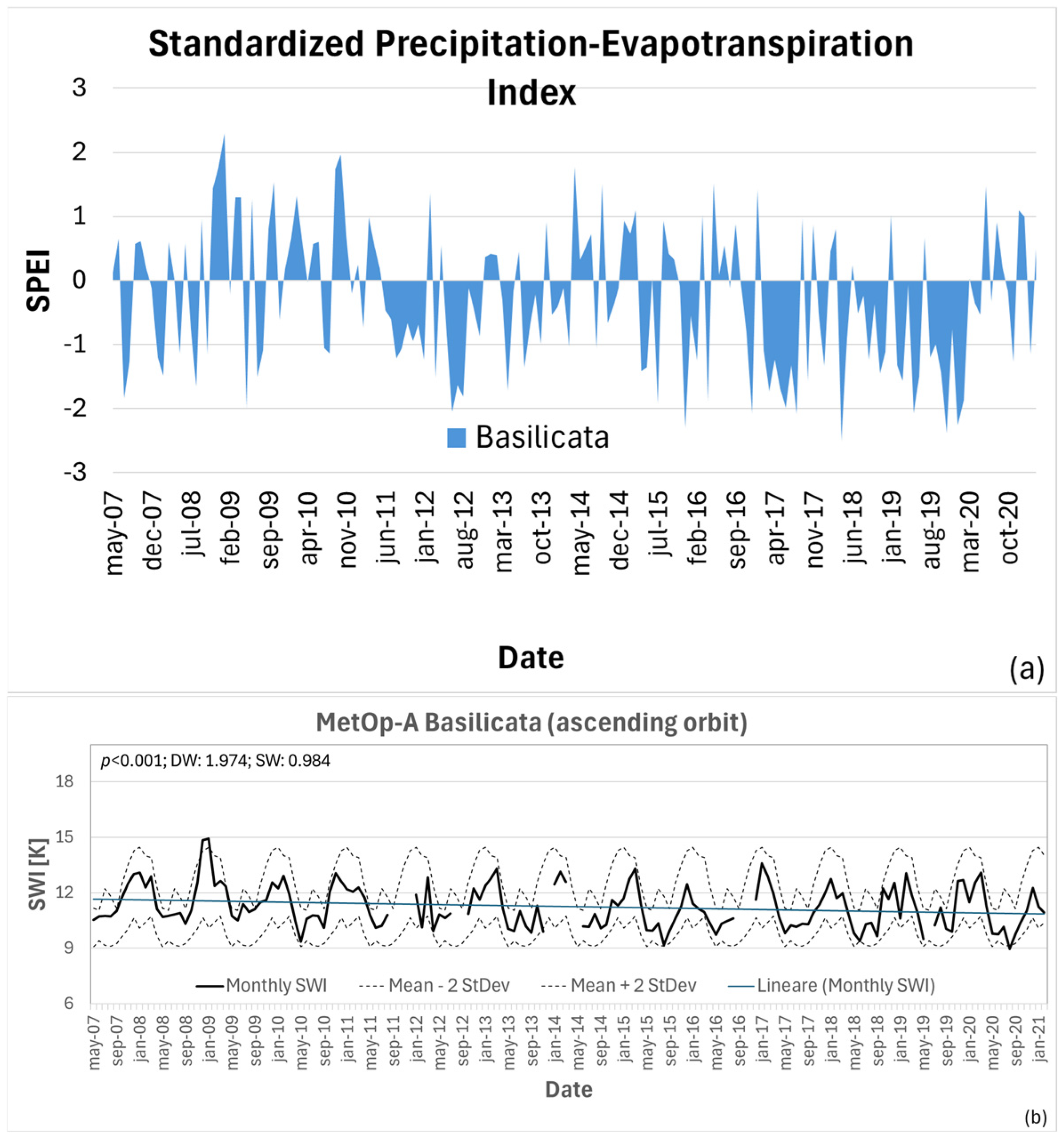
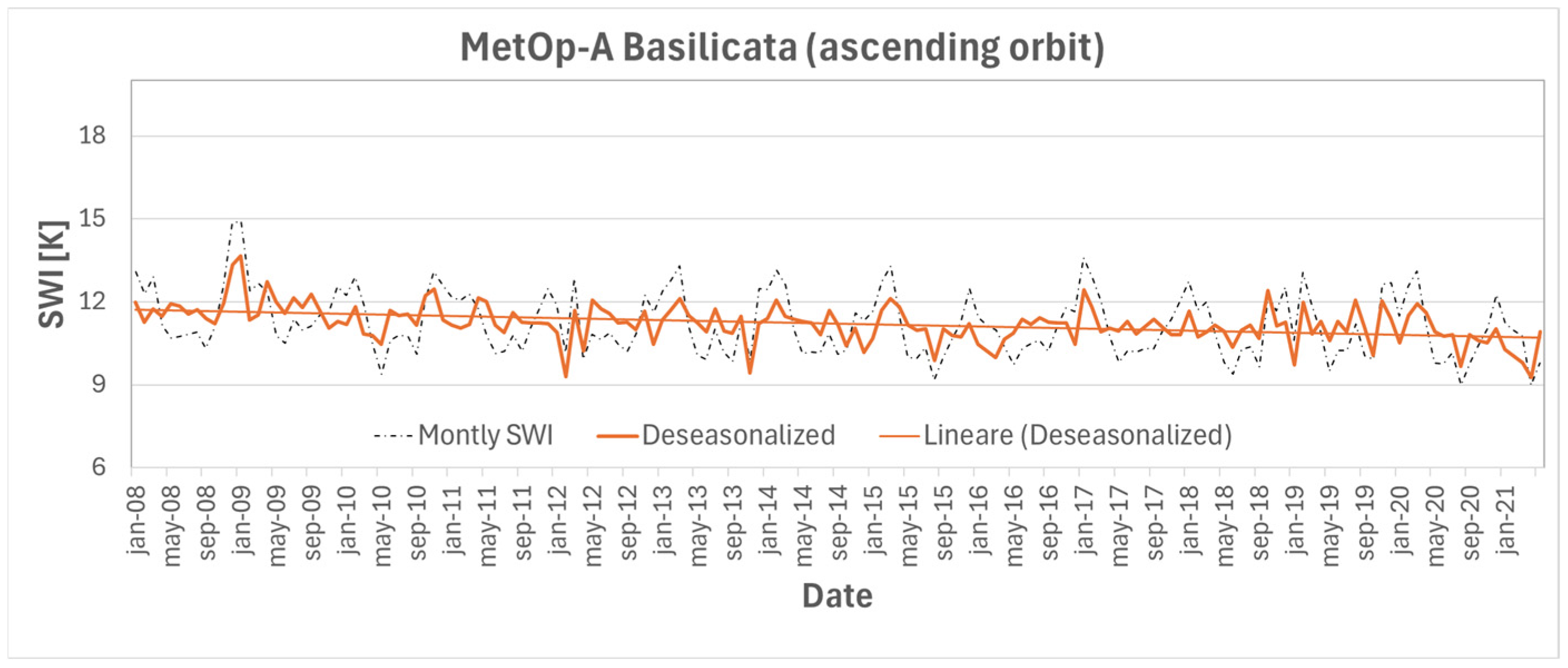
| Ascending Orbit (Around 09:30 UTC) | Descending Orbit (Around 21:30 UTC) | |
|---|---|---|
| MetOp-A | May 2007–March 2021 | May 2007–February 2010 |
| MetOp-B | January 2013–October 2016 | January 2013–October 2016 |
| MetOp-B Asc | |||||
|---|---|---|---|---|---|
| Agri | Basento | Bradano | Sinni | Basilicata | |
| Agri | --- | ||||
| Basento | 0.90 | --- | |||
| Bradano | 0.78 | 0.94 | --- | ||
| Sinni | 0.94 | 0.85 | 0.69 | --- | |
| Basilicata | 0.95 | 0.98 | 0.92 | 0.90 | --- |
| Mean | 0.91 | 0.94 | 0.86 | 0.88 | 0.95 |
| MetOp-B Des | |||||
| Agri | Basento | Bradano | Sinni | Basilicata | |
| Agri | --- | ||||
| Basento | 0.95 | --- | |||
| Bradano | 0.88 | 0.94 | --- | ||
| Sinni | 0.91 | 0.85 | 0.78 | --- | |
| Basilicata | 0.97 | 0.97 | 0.95 | 0.90 | --- |
| Mean | 0.94 | 0.94 | 0.85 | 0.89 | 0.96 |
| Agri | Basento | Bradano | Sinni | ||
|---|---|---|---|---|---|
| Agri | --- | Agri | |||
| Basento | 0.90 | --- | Basento | ||
| Bradano | 0.81 | 0.92 | --- | Bradano | |
| Sinni | 0.90 | 0.90 | 0.73 | --- | Sinni |
| Basilicata | 0.94 | 0.94 | 0.92 | 0.86 | Basilicata |
| Mean | 0.87 | 0.91 | 0.87 | 0.83 | Mean |
| Agri | Basento | Bradano | Sinni | |
|---|---|---|---|---|
| Linear regression slope | −0.00598 | −0.00595 | −0.00797 | −0.00646 |
| Sen’s slope | −0.00580 | −0.00588 | −0.00693 | −0.00668 |
Disclaimer/Publisher’s Note: The statements, opinions and data contained in all publications are solely those of the individual author(s) and contributor(s) and not of MDPI and/or the editor(s). MDPI and/or the editor(s) disclaim responsibility for any injury to people or property resulting from any ideas, methods, instructions or products referred to in the content. |
© 2025 by the authors. Licensee MDPI, Basel, Switzerland. This article is an open access article distributed under the terms and conditions of the Creative Commons Attribution (CC BY) license (https://creativecommons.org/licenses/by/4.0/).
Share and Cite
Albano, R.; Lahsaini, M.; Mazzariello, A.; Pham-Duc, B.; Lacava, T. Study on 2007–2021 Drought Trends in Basilicata Region Based on the AMSU-Based Soil Wetness Index. Land 2025, 14, 1239. https://doi.org/10.3390/land14061239
Albano R, Lahsaini M, Mazzariello A, Pham-Duc B, Lacava T. Study on 2007–2021 Drought Trends in Basilicata Region Based on the AMSU-Based Soil Wetness Index. Land. 2025; 14(6):1239. https://doi.org/10.3390/land14061239
Chicago/Turabian StyleAlbano, Raffaele, Meriam Lahsaini, Arianna Mazzariello, Binh Pham-Duc, and Teodosio Lacava. 2025. "Study on 2007–2021 Drought Trends in Basilicata Region Based on the AMSU-Based Soil Wetness Index" Land 14, no. 6: 1239. https://doi.org/10.3390/land14061239
APA StyleAlbano, R., Lahsaini, M., Mazzariello, A., Pham-Duc, B., & Lacava, T. (2025). Study on 2007–2021 Drought Trends in Basilicata Region Based on the AMSU-Based Soil Wetness Index. Land, 14(6), 1239. https://doi.org/10.3390/land14061239











